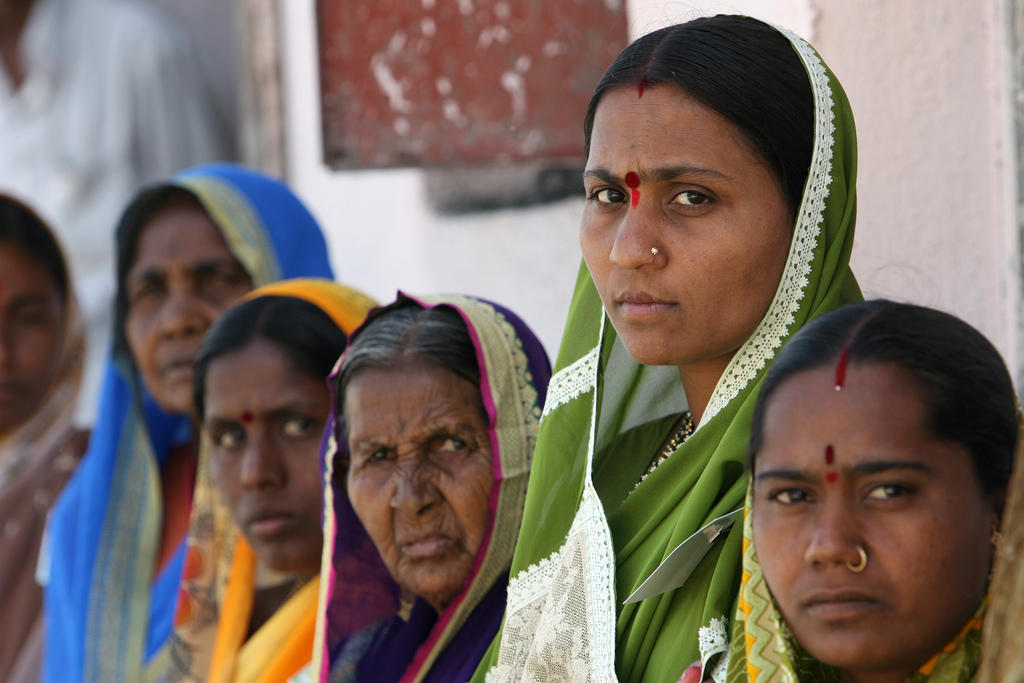A decision earlier this week by a Delhi court that forcible sex between a husband and wife doesn’t constitute rape highlights an issue that has been increasingly part of India’s policy conversation during this campaign season — violence against women, in particular, and gender equality, more generally. ![]()
The brutal rape and murder of a 23-year old in Delhi in December 2012 caused a national sensation and an outpouring of sympathy and anger. The governing Indian National Congress (Congress, भारतीय राष्ट्रीय कांग्रेस) was immediately met with calls for legislation designed to increase urban safety for women and to institute stricter criminal penalties for rape. The girl, whose name was initially withheld from media reports, has come to be known by many pseudonyms, the most common of which is ‘Nirbhaya,’ which means ‘fearless one’ in Hindi.
In March 2013, following the conclusions of a panel committee established to consider legal reforms, India’s parliament enacted new, stronger anti-rape laws. Although the laws lengthened jail sentences for rape and related crimes and introduced the death penalty for repeat offenses, they also created new offenses, such as stalking and voyeurism, which weren’t previously illegal. The laws also expand the definition of rape, and they relax some of the burdens required for a conviction — for instance, a victim no longer has to prove physical struggle to show lack of consent.
Critics of the new laws argue that they still aren’t strong enough. For example, marital rape is still not illegal. Moreover, the legal reforms did nothing to address Section 377 of the Indian penal code, which criminalizes same-sex conduct, a statute that the Indian supreme court upheld last December, nor do they particularly address the challenges of transgendered Indians. (Though the Indian supreme court a month ago recognized transgender as a third gender category in a ruling that LGBT advocates hailed as a landmark decision.)
* * * * *
RELATED: Is there a potential parliamentary path to amending Section 377 in India?
* * * * *
Even as activists worry that the current government’s steps don’t go far enough, they also worry that a government led by Narendra Modi and the conservative, Hindu nationalist Bharatiya Janata Party (the BJP, भारतीय जनता पार्टी) could be even worse. Exit polls, though not incredibly accurate in the past, forecast a strong Modi victory when election results are announced on May 16.
* * * * *
RELATED: In-Depth: India’s Elections
* * * * *
Both Modi and Rahul Gandhi, who is leading the Congress election effort, have railed against sexual violence and invoked the memory of Nirbhaya in their campaign rallies. But whether you prefer Modi or Congress depends on your perspective about the roots and causes of sexual violence in India.
Modi supporters view the issue in terms of good governance and law and order, and they point to generally low crime rates in the major cities of Gujarat, where Modi has served as chief minister since 2001. If Modi’s strongest suit as a potential prime minister is his claim as an able administrator who can make government work more efficiently — not only in respect of economic policy, but also with regard to judicial responsiveness and effective criminal prosecution — you might prefer Modi to another five years of Congress.
Many Indian voters, even those who oppose Modi, agree with him that a decade of Congress rule has only encouraged the kind of corruption, bureaucracy and impunity that has made government less responsive to effectively dealing with crime, safety and justice.
Congress supporters, however, argue that its secular approach to governance has a more respectful view of gender equality than the Hindu nationalist view espoused by Modi and the BJP. As Amana Fontanella-Khan wrote last month in Foreign Policy, the Hindu values that Modi would bring to government aren’t necessarily progressive:
Hindutva ideologues often celebrate women who are sexually pure, subservient, and domestic. Mohan Bhagwat, the head of the right-wing Hindutva organization Rashtriya Swayamsevak Sangh, which Modi campaigned with in his 20s and 30s, reportedly said in January 2013 that when “women living in cities follow a Western lifestyle,” rape happens…. Urvashi Butalia, who co-founded Kali for Women, India’s first feminist publishing house, told AFP, “The BJP has never been particularly known for its progressive attitudes toward women, and there’s no reason to believe a Modi government would be good news for women.”
Fontanella-Khan highlights any number of additional troubling signs that a Modi government would be bad for women — the troubling rapes that accompanied the 2002 Gujarati riots that Modi’s state government failed to stop, not to mention the creepy ‘Snoopgate‘ rumors that Modi had a woman followed by state officials for up to two months. Even giving Modi the benefit of the doubt, administering Ahmadabad and Gandhinagar, the largest cities in Gujarat, are hardly the same as administering Mumbai and Delhi.
So where does that leave the cause of promoting gender equality and reducing sexual violence in a Modi government? It’s perhaps important to remember that an upswell of Indian civil society demanded Congress’s action on legal reform in the first place, and it’s the pressure from everyday Indian citizens that can propel further progress. That’s true regardless of the administration — and it’s even, perhaps, a template for further reform in other areas of policy advancement as well in the years ahead.
Photo credit to Simone D. McCourtie / World Bank.
